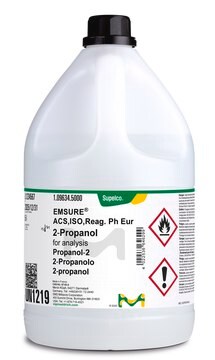Kluczowe dokumenty
1576708
USP
Glikol propylenowy
United States Pharmacopeia (USP) Reference Standard
Synonim(y):
1,2-Propanediol, Propylene glycol
About This Item
Polecane produkty
klasa czystości
pharmaceutical primary standard
gęstość pary
2.62 (vs air)
ciśnienie pary
0.08 mmHg ( 20 °C)
rodzina API
propylene glycol
temp. samozapłonu
779 °F
granice wybuchowości
12.5 %
producent / nazwa handlowa
USP
współczynnik refrakcji
n20/D 1.432 (lit.)
bp
187 °C (lit.)
mp
−60 °C (lit.)
gęstość
1.036 g/mL at 25 °C (lit.)
Zastosowanie
pharmaceutical (small molecule)
Format
neat
ciąg SMILES
CC(O)CO
InChI
1S/C3H8O2/c1-3(5)2-4/h3-5H,2H2,1H3
Klucz InChI
DNIAPMSPPWPWGF-UHFFFAOYSA-N
Szukasz podobnych produktów? Odwiedź Przewodnik dotyczący porównywania produktów
Opis ogólny
Zastosowanie
Also used to prepare standard stock, standard, sample, system suitability, and sensitivity solution for assay and impurity analysis according to the given below monographs of United States Pharmacopeia (USP):
- Propylene Glycol Dilaurate
- Phenytoin Sodium Injection
- Hydroxypropyl Betadex
- Butylene Glycol
Komentarz do analizy
Inne uwagi
produkt powiązany
Kod klasy składowania
10 - Combustible liquids
Klasa zagrożenia wodnego (WGK)
WGK 1
Temperatura zapłonu (°F)
219.2 °F - closed cup
Temperatura zapłonu (°C)
104 °C - closed cup
Wybierz jedną z najnowszych wersji:
Certyfikaty analizy (CoA)
It looks like we've run into a problem, but you can still download Certificates of Analysis from our Dokumenty section.
Proszę o kontakt, jeśli potrzebna jest pomoc Obsługa Klienta
Masz już ten produkt?
Dokumenty związane z niedawno zakupionymi produktami zostały zamieszczone w Bibliotece dokumentów.
Klienci oglądali również te produkty
Protokoły
99%; Glycerol, ≥99.5%; Tetraethylene glycol, 99%
Nasz zespół naukowców ma doświadczenie we wszystkich obszarach badań, w tym w naukach przyrodniczych, materiałoznawstwie, syntezie chemicznej, chromatografii, analityce i wielu innych dziedzinach.
Skontaktuj się z zespołem ds. pomocy technicznej






